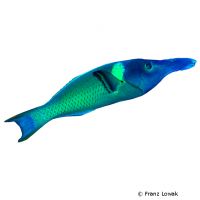Bird Wrasse (Gomphosus varius)
| Bird Wrasse Gomphosus varius | |
|---|---|
| Name | Bird Wrasse |
| Name Lat. | Gomphosus varius |
| Family | Wrasses |
| Family lat. | Labridae |
| Order | Wrasses & Relatives |
| Order lat. | Labriformes |
| Origin | Indo-Pacific |
| Habitat | Coral reefs, lagoons |
| Diet | Carnivore |
| pH | 8,1-8,4 |
| Hardness | 8-10 °KH |
| Behavior | Semi-aggressive |
| Keeping | Individual |
| Reef Compatible | With caution |
| Care Level | Difficult |
| Life Span | 8-12 years |
| Protection | No |
| Metric Units | |
| Size | 30 cm |
| Temperature | 22-27 °C |
| Salinity | 33-36 ‰ |
| Aquarium | ~ 750 l |
| US Units | |
| Size | 12" |
| Temperature | 72-81 °F |
| Salinity | 1.020-1.025 sg |
| Aquarium | ~ 200 gal |
Distribution and habitat
The wide range of Gomphosus varius extends from the eastern Indian Ocean to the central Pacific around Hawaii and the Tuamotu Islands, where they live in coral-rich lagoons and sheltered outer reefs down to 30 m depth.
Maintenance
They need a well structured aquarium with rock or stone structures with living stones, which offer enough hiding and covering possibilities as well as sufficient swimming space and a bottom substrate consisting of an approx. 20 cm deep sand layer (no coral rubble!). Only lime-rich, heavy metal-free sands, gravels, stones or sea sand may be used.
Filters, skimmers and heaters are necessary to ensure water quality, as well as pumps to simulate tides, swell and bottom currents. Lighting must be appropriate for the species' day-night rhythm
| Salinity: 33-36 ‰ | pH value: 8.1-8.4 |
| Carbonate hardness: 8-10 °KH | Nitrate content: 2-8 mg/l |
| phosphate content: 0.01-0.1 mg/l | nitrite content: 0.0-0.05 mg/l |
For salinity, an average value should be aimed for, which may only vary slightly by +/- 0.5 ‰. Ammonia and ammonium must not be measurable. Special attention must be paid to constantly good water quality.
Diet
They feed on small fish and crustaceans. The food change is not always successful without problems. The food supply should consist of a combination of small cut shrimp, mussel and crab meat with live and frozen food, such as mysis, krill, artemia and shrimp or a frozen food mixture enriched with vitamins. High-quality flake and granulated food is also often accepted after an acclimation period
It is recommended to feed small portions several times a day, this reduces intra-species aggression and protects lower animals in the aquarium
Regular and varied feeding promotes health and increases resistance.
Behaviour and compatibility
Juvenile animals can be kept in a group. With the sex change to male the aggression increases and they should be kept individually. With sufficient swimming space, socialization with other not too small and defensible fish is possible.
Sex dimorphism
They are protogynous hermaphrodites, i.e. most males develop from functional females and are called "secondary males". They are more colorful than "primary males" (born as males). These are dark blue in color.
Reproduction and breeding
There are no known reports of successful breeding in the aquarium.
Important
They rummage through the ground for food and when threatened, they burrow into the ground
Care should be taken when keeping them together with tubeworms, shrimps and crayfish, as these can be considered food.
If different species are kept together, care should be taken to ensure that the fish match each other in terms of water quality and temperature requirements and social behavior, and that the setup meets the needs of all species kept together. New fish to be introduced must be acclimated slowly to the water in the aquarium
Further literature can be found in your pet store.
References
Text: Werner Winter; Image: Franz Lowak
Source: KUITER, DEBELIUS (2007): Atlas der Meeresfische: Die Fische an den Küsten der Weltmeere, Kosmos Verlag; BAENSCH & DEBELIUS (2006): Meerwasser Atlas Bd. 1, Mergus Verlag; ENGELMANN (2005): Zootierhaltung - Tiere in menschlicher Obhut: Fische, Verlag Harri Deutsch
- Gemäß § 21 Abs. 5 Tierschutzgesetz idgF
